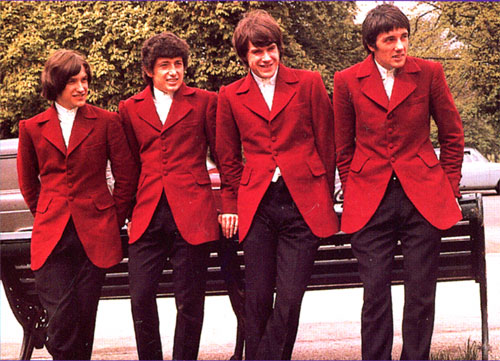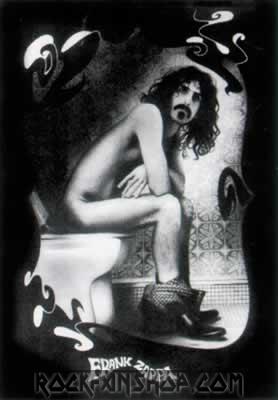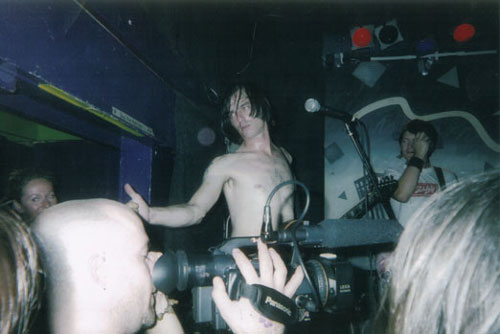| LAYING
DOWN THE GAUNT-LET:
Rock n’ roll is basically a thin man’s art (hence Dylan, “Ballad of a Thin Man”). Oh, there have been exceptions throughout the years: Fats Domino, Leslie West, the Minutemen (I refuse to refer to Meatloaf as “rock,” however). But, for the most part, the prima facie of rock n’ roll is that of the drippy beanpole, with his hair flopping in his face, leaning on the mikestand, almost as if it’s holding him up. Once again, there’ve inarguably been fat rockers who’ve made enormous contributions to the sound and stance of rock n’ roll...particularly in the early years. But as I explained in Sonic Cool, that’s because, at that time, rock n’ roll still had a workingman’s element to it, and of course working men ain’t lookin’ in the mirror every fifteen seconds checking their girlish figures (least of all in the FIFTIES). But as someone once told the Points, Portland’s own reigning skinnies: “It’s a style issue.” Ever since the BRITS in the sixties forever conjoined the worlds of fashion and rock, the longstanding prototype for rock n’ roll has been that of the gaunt frontman with his two or three lean, droogy henchmen (cigarettes and droopy hair complete the package). This is the image Greg Shaw, pretending to be Richard Meltzer on the liner notes to the first Pebbles, described as the “praying mantis” look—mainly five well-tailored insectoids, looking slightly damaged, sawing away on their musical wings w/ buzzing intensity. The Stones would be the obvious antecedent, but, let’s face it, amongst the whole Brit invading brigade there was hardly a fatty in sight: the Stones, Kinks, Yardbirds, Who, Beatles—all slight, almost waifish “men.” We won’t even mention the Velvet Underground, because that’s where DRUGS get involved directly with the thinness factor, and that era was still a couple years away. Now we’re addressing the FASHION aspects, and the Brits were the catalysts. But of course! Swingin’ London was exploding with Mary Quant and David Bailey and the Stones, who’d yet to become outright druggies, but were in the thick of it. In fact, it was during this era that the tide began to turn in the rock wars and the consensus among the ultra-hip began to shift away from the Beatles in favor of the Stones. In Tom Wolfe’s book The Kandy Kolored Tangerine Flake Baby, he quotes Warhol superstar Jane Holzer waxing dismissive of the Beatles because they were “too fat”—Lennon in particular. In fact, this unfortunate incident might’ve induced the first flowering of John Lennon’s paranoid tendencies—and probably fueled his drug use (resulting in his resumption of skinniness soon thereafter). At least according to Albert Goldman in his biography, Lennon (where Goldman, a known fatty, refers to Holzer as an “idiot”). However, it was once again the Stones who really made the argument for rock n’ roll gauntness, and from then on, nary a fat man, or even remotely stocky man, would occupy the front-man role, let alone that of the baleful henchmen. Once again, there were exceptions: Eric Burdon, who was surely amongst the very cognoscenti of the counter-culture, was at least portly—but actual fats were hard to find, and, when they were, they were quickly relegated to a much less-visible role (e.g., Burden’s old band-mate Chas Chandler, who soon retired from bass-playing duties to manage Jimi Hendrix in a strictly behind-the-scenes capacity). Dylan shouldn’t be overlooked in the emaciated stakes either—his hunched-shouldered irreverence, coupled with kinky hair a mile high, and the ever-dangling cigarette, was as important to the street-junkie persona of rock n’ roll as the Stones. Keith Richards copied Dylan’s haircut, and took it a step further, becoming an actual junkie. Needless to say, this only increased the caved-in look that he was perfecting, coupled with kohl smeared around his eyes that made him really look like a deathface. It was only a short time before Johnny Thunders would take it even further, transforming the deathface into an actual corpse, all the while remaining cellulite-free. On the other side you had the Velvets, and the whole Warhol scene in particular. As the artist himself said in his immortal book, Popism: “All the queens were skinny, except the Duchess”—i.e., Brigid Berlin—“who was fat.” (Sniffed with utter contempt, no doubt.) The point was, the Velvet Underground, with their sparse and irregular eating habits, fit right in with the diet-pill popping denizens of the Factory. Lou Reed wrote some of his most glorious odes to chemical calorie-burning during those years — “Heroin,” “I’m Waiting for the Man” and “White Light/White Heat,” among them — and the image of the junkie became inextricably linked to rock n’ roll. Coupled with the image Keith Richards was projecting at the time, this guaranteed the seventies were going to be the leanest decade yet, at least as far as rock goes. This was REALLY the age when the stork-like front-man came to the fore, be it such anorexic wonder-boys as Alice Cooper, David Bowie and Rod Stewart, or the flippantly arrogant Freddie Mercury or Steven Tyler. In a way, the arch thinness only added to the collective consummate sneer of rock stardom, be it the hippie-dirtbag emaciatedness of a Frank Zappa, the loincloth-draped “noble savage” pose of a Ted Nugent, or the wrist-flicking contempt of an Ian Hunter (who also copped the Dylan mile-high hair...perhaps not by accident: one thing you have to remember about all these Brits was that they were, or are, short, and everyone knows lank adds height—a lot more than being shaped like a hamster). Once again, there were a few fat rockers: the Guess Who, BTO, the aforementioned Leslie West. But these chunk-a-lunks were definitely the exception, not the rule, and were hardly the public image of rock in the seventies, which was occupied by Robert Plant, Mick, Rod, Freddie, Iggy and all the other skinnies. Ian Anderson of Jethro Tull, another beanpole, actually wrote a song called “Fatman,” which outright made fun of fatties. That’s how bad it was if you were fat in the seventies.
Then there were the hippies. Now, originally, the denizens of Woodstock Nation, due to their anti-materialist lifestyles, were thin, if only because they couldn’t afford to eat. But as the counter-culture expanded in the sixties, so did some of the waistlines of the hippie millionaires (pushing those belt buckles and bell bottoms to their most expansive frontiers). Such rock icons as Jerry Garcia and “Pigpen” Ron McKernan of the Grateful Dead, Janis Joplin and David Crosby—not to mention the dude in Canned Heat—cast a long shadow, in more ways than one, and even former model Grace Slick pushed the pork barrier, at least after she started drinking a fifth of vodka every day. And speaking of drinking, even Jimbo Morrison ballooned to almost Orson Welles proportions during his final years. Surely, the country-rock and southern boogie brigades of the mid-to-late seventies made no effort to shield their girth, and slobs ran amok in the bloated form of the Outlaws, Marshall Tucker, Lynyrd Skynyrd, Wet Willie etc. We were entering the age of casual dress as well, so that, unlike Bowie etc., the average rockstar could now walk onstage looking like he might as well be pumping gas at the local Sunoco. There was somewhat of a prole element that was creeping back into rock—i.e., Bruce Springsteen—after the years of aristocratic vanity. It seemed as if the sartorial element of rock—introduced by the mods in the sixties—was being usurped by the ultra class-conscious phenomenon of disco. But the dirty little secrets of the disco culture would become apparent in a few years—it wasn’t only the dancing-the-night-away that helped the ever-fashion-phobic disco-ers maintain their girlish frames. It was also the fact they were all on coke, and a great deal of them were dying of AIDS (which was still unnamed at the time, but already casting a pallor amongst the disco crowd). But the whole snooty fashion-conscious aura of disco would surely live on in the eighties, in the form of Madonna and other waist-pinching preeners. In an ironic twist, due to the health-conscious trend of the era, thinness was no longer an emblem of wasted elegance, but a sign of athleticism brought about not by skipping meals and staying awake for four days straight while wasted on a plethora of euphoria-inducing chemicals, but by adhering to a healthy diet and exercising (which would’ve been anathema to Jim Morrison, Keith Richards, Hendrix and the other ultra-gaunt sixties rockstars). Then there was punk. Surely there were no fat people in the Ramones, Sex Pistols, Clash, Television etc. and such withered champs as the Sex Pistols' Sid Vicious and the Dead Boys' Stiv Bators took the wasted eloquence of the Stooges and Thunders to a whole new level. Furthermore, bands like the Jam, who, image-wise, were based on the whole mod phenomenon of the sixties, weren’t about to employ a fatty. It would be simply gauche, and this prejudice against people of girth has plagued British rock ever since, from the Smiths (who added homosexuality as a raison d’etre for their thinness) to Oasis (who were closet fat-boys who beat up any photographer who’d take a picture of them from their unflattering side). Elvis Costello, meanwhile, was twerpish and bug-eyed, but hardly fat (not until later years anyway, when, like Oasis, he’d eaten one too many cheeseburgers). Patti Smith continued in the gypsy wastrel tradition of Keith and Thunders. But punk by its very egalitarian nature suggests that anybody can do it, and of course some fatties did—the VoidOids’ guitarist Robert Quine, for instance, had a beer-gut, as did one of the guys in the Saints. And let’s not forget David Thomas of Pere Ubu, or Lester Bangs. Once the indie revolution began, then it was anybody’s game. With the whole concept of “rock stardom” quaintly passe, and image-mongering in general looked down upon, finally fatboys had an even playing field, and came out in droves: the Minutemen, Husker Du, Charlie Pixie. Of course the ultimate anti-hero-turned-rock-n’-roll-suicide, Curt Cobain, reverted right back to the wasted posture, dying under tragic circumstances like a typical rock n’ roll junkie. But when you got down even further beneath the surface of the eighties indie underground, fatties weren’t only accepted, but widely (no pun intended) appreciated. Bands like Poison Idea, the Mentors and Kilslug, far from trying to HIDE their beerguts, flaunted fatness as part of their bad-ass modus operandi. It fit in with punk’s ultimate desire to offend everyone, and what could be more offensive—especially to the appearance-conscious hordes of disco and Madonna—than the sight of some drunk fat slob playing the most obnoxious music possible? Suddenly, as the nineties dawned, nobody cared anymore about the more superficial trappings of celebrity. For “grunge” groups like Screaming Trees, it actually became part of their whole allure that they were fat. Leave it to the always image-conscious Brits to revert to the same old class warfare. All through the eighties and nineties, Brit bands like Spacemen 3, the Jesus & Mary Chain, the Vaselines and the La's were affecting “mod” postures. Then when Manchester erupted, and the ecstasy-eating hordes flocked to the rave scene to gyrate frenetically all night to the sound of the Happy Mondays and Stone Roses, there was little hope that a fatty would ever be seen again on the isle of Britain. The complete mod makeover of Brit-pop, ultimately ending in the Madonna-times-five sweepstakes of the Spice Girls, only reinforced this “pretty people only” aura, which continued in the form of not only such post-Britpop leansters as the Libertines, but such American post-everything treasures as the Dandy Warhols and Brian Jonestown Massacre. The thing is, at this point, the leniency towards fatness had so permeated the realm of modern music that even a band with as carefully cultivated an image as the Jonestown could afford to have the portly tambourine-player Joel Gion onstage amongst the praying mantises, although in his case, his presence was like that of Bunk Gardner in the Mothers, or Howie Kaylan of the Turtles—his role as a spiritual center for the group, as well as an object of much-needed “comic relief,” far outweighed (no pun intended) his defiance of the cookie-cutter “mod” profile. And what we’re talking about here is slight portliness, not outright fatness. None of the Jonestown would win any athletic competitions most likely, although 5’7 leader Anton Newcombe claims to be a full-fledged judo champ as well as listing his body-type” as “slender” on his myspace profile so he’s earned the right to take his shirt off in public just like Iggy before him.
That brings us to the Strokes, and the whole New Millennium brigade. There’s no way there could’ve been a fat guy in the Strokes, since Julian Casablancas’s dad was a fashion-industry honcho, and let’s face it, in the fashion world (as well as art world) there’s nothing more gauche than a lard-ass. After all, the Strokes had no less than two members named Fabio, so there’s no way they’re gonna have anything more than concave waistlines. In fact these guys are so hopelessly vain that they probably wouldn’t want to be in the room with a fatty. To paraphrase the Warhol crowd: “Eeeeh! Who brought that thing in here?” That’s the Strokes attitude, which makes them no different from previous would-be divas from Bowie to Ric Ocasek. Once again, the worlds of rock and fashion have been intertwined since the sixties, and the Strokes did more than anybody in the new millennium to re-emphasize this fact, after years of roley-poley everyman clowns like Blues Traveler or whatever. You know, the “regular guy” syndrome that had inhabited rock since the seventies, when the bluejean and beer-swilling crowd forsook the fashion element altogether, making the world a better place for fat people, no doubt, but also helping to turn rock a whole lot less glamorous. Couple this with the indie hordes like Pavement, who did little to even distinguish themselves as “rock stars,” eschewing any kind of image whatsoever. And while there were no actual fat-boys in Pavement, there was one pumpkin-head, so you know, fatness was within the realm of possibility; whereas, with the Strokes and their ilk, it wasn’t even an option. Rock stardom was restored to its rightfully withered facade. (Then again, how does one explain JACK WHITE, who’s somewhat pudgy?) What it all proves is that, since the fifties, we’ve seen the debate on fatness go full circle (ignore obvious pun). While fatmen like Fats Domino and Big Joe Turner (and later, Elvis) were known and loved for their girth, the metabolical alchemy of the sixties assured that thin would remain in until the face of rock n’ roll was wiped clean. We should also mention that, in the realm of Hip Hop—which has more or less supplanted rock in the popular culture—fat has whole other connotations. Rotund rappers are not hard to find (the late Big E. Smalls being only the most famous example). This is because, in the black community, which has suffered more economic hardship than the white one, being fat is a sign of having made it, plus it’s ATTITUDE, which is a major part of rap. That is, “I’m a rich NIGGA so I can afford to be fat and STILL get laid” etc. It makes them more BADASS to be fat, and the extreme edge of METAL has adapted this somewhat as well. But to pale-face artifices like the Strokes and their ilk, who date fashion models and have pedigrees within the fashion industry, a few extra pounds is the kiss of death. In a field filled with as much vanity as rock n’ roll, thinness will probably always remain an issue. Despite Blues Traveler and other slobs, fatness exhibits a degree of comfort that goes against the street-hood persona of rock. You can’t run away from the cops as well when you’re fat, and you can’t wear unisex clothes. And the whole junkie-outlaw thing, which started in the sixties, rendered food far behind sex and drugs in the priorities of most rock n’ rollers. Ironically enough, perhaps the truest “rock star” in the current media pantheon, Anthony Bourdain, hails not from the music world at all, but the world of cuisine. As others have suggested, in the new millennium, chefs are the new rock stars...but beyond Bourdain the food world is a “ton of fun” with such rotundos as Paula Dean, Emeril Lagasse and Mario Batali reigning supreme. Bourdain’s among the few lean exceptions, and he had to take heroin for 15 years in order to do it. Either way,
as audiences have proven for centuries, whether you’re fat
or thin, if you’re good enough at what you do, you’ll
be loved for it. So go ahead, if you’re an aspiring musician,
eat that cheeseburger—somewhere in the void Mama Cass is smiling.
|



